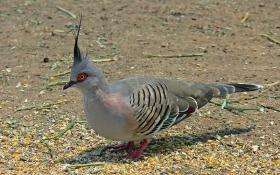When a whistle beats a tweet

Biologists have discovered that a species of Australian pigeon has a secret way of alerting fellow birds to predators -- a "whistle" emitted by flapping wings when the bird takes off in alarm.
The crested pigeon (Ocyphaps lophotes) is well known for the abrupt metallic-sounding whistle that it makes on takeoff.
Until now, though, no-one has analysed the sound or explored whether it may have a use.
Robert Magrath and Mae Hingee of the Australian National University in Canberra recorded a crested pigeon as it tucked into grain on a feeding table.
They tossed a model of a accipiter hawk from behind a hide to capture the sound of the bird taking off in fright.
They then recorded the takeoff of a bird as it flew unprompted from a flock, unbothered by any threat.
Magrath and Hingee discreetly played back the two sets of whistles to 15 groups of birds to see what happened.
The first whistle stirred flocks to take to the skies in panic, whereas the second caused no disturbance.
To the human ear, the two whistles may well seem simple and identical but acoustic analysis shows the sounds to be quite complex and distinct, the investigators say.
The whistles each comprise two tonal elements and an atonal "clap".
But the "alarm" version of the whistle is louder and has a more rapid tempo than the "non-alarm" version -- and the pigeons easily spot the difference.
Many birds have the ability to make vocal cries to alert other members of their flock, but this is the first proof that flight noise can also serve as an alarm call, the scientists believe.
The whistle is probably produced by the vibration of an unusually slender primary feather in the pigeon's wingtip, they say.
This suggests that the whistle evolved not as a by-product of flight but as a warning signal to help the species survive.
The paper appears in Proceedings of the Royal Society B, a journal of Britain's Royal Society.
(c) 2009 AFP


















